by
GORDON GUNTER
Gulf Coast Research Laboratory, Ocean Springs,
Mississippi 39564, U.S.A.
and
JUDITH CLARK EDWARDS 1
Department of Biology, University of Mississippi,
Oxford, Mississippi 38655, U.S.A.
Abstract
The catch of white shrimp off Texas from 1927 to 1964 showed a strong statistical correlation with the total rainfall of the state, the highest correlations being (i) between the year's catch and the rainfall of the previous two years and (ii) between the year's catch and the combined rainfall of the year and the previous two years.
No correlation was found between catches of brown shrimp and rainfall in Texas, or between catches of either species in Louisiana and the outflow of the Mississippi and Atchafalaya Rivers.
The results are discussed in relation to the behaviour of larvae and postlarvae of white and brown shrimp.
1 Present address: Duke University Marine Laboratory, Beaufort, North Carolina 28516, U.S.A.
RAPPORT ENTRE LES PLUIES ET LE RUISSELLEMENT ET LA PRODUCTION DES CREVETTES Penaeus fluviatilis SAY ET Penaeus aztecus IVES DANS LES EAUX DU TEXAS ET DE LA LOUISIANE
Résumé
Les prises de Penaeus fluviatilis au large du Texas de 1927 á 1964 manifestent une forte corrélation statistique avec le total des chutes de pluie dans cet Etat, et plus particulièrement: (i) entre les prises de l'année et les précipitations des deux années précedentes; (ii) entre les prises de l'année et les pluies globales de l'année et des deux années précédentes.
Il n'a pas été révélé de corrélation entre les captures de Penaeus aztecus et les chutes de pluie au Texas, ni entre les prises des deux espéces en Louisiane et l'apport du Mississippi et de l'Atchafalaya.
Les résultats sont examinés en liaison avec le comportement des larves et des postlarves de Penaeus fluviatilis et de P. aztecus.
LA RELACION ENTRE LA LLUVIA Y LA ENTRADA DE AGUA DULCE CON LA PRODUCCION DE PENEIDOS (Penaeus fluviatilis SAY Y Penaeus aztecus IVES) EN LAS AGUAS DE TEXAS Y LOUISIANA
Extracto
Las capturas de camarón blanco en aguas de Texas desde 1927 a 1964 señalaron una gran correlación estadística con las precipitaciones totales en el Estado, siendo las mayores correlaciones entre (i) la captura del año y las lluvias de los dos años anteriores y (ii) entre la captura del año y las precipitaciones combinadas de tal año y de los años anteriores.
No se encontró ninguna correlación entre las capturas de camarones café y las lluvias en Texas, o entre las capturas de ambas especies en Louisiana y la descarga de las aguas de los ríos Mississippi y Atchafalaya.
Se discuten los resultados en relación con el comportamiento de las larvas y las postlarvas de los camarones blanco y café.
Marine biologists and fishery workers on the Gulf Coast remember when scientists considered the Gulf of Mexico to be a warm semitropical, clear and barren sea - a Mediterranean - which would never amount to much in terms of fishery production. It was thought that insufficient nutrients entered the Gulf to support large populations of animals. This type of appraisal was still being made public after the Gulf States Marine Fisheries Commission was organized in 1949. The errors of this concept were discussed at the meeting of the Commission in Louisiana in October 1966.
Actually, the situation was quite the opposite. Gunter (1963), showed that coastal waters from Pascagoula, Mississippi, to Port Arthur, Texas, produce 20 percent of the fishery products of the United States, and he named this region “The Fertile Fisheries Crescent”. The Gulf of Mexico produces 28 to 30 percent of the total fishery products of the United States. Gunter (1963) showed that between 1936 and 1962 Alaska fishery production decreased by over 50 percent, the production of Pacific Coast States declined by 66 percent, and that of the Atlantic Coast increased by 33 percent. In the same period, production from the Gulf Coast increased by 700 percent, or 7 times its former production.
The shrimp fishery of the southern states of the U.S.A. depends mostly upon species of the family Penaeidae and is the most valuable in the country. Landings at ports in Texas, Louisiana and the west coast of Florida regularly amount to 80 percent of the southern states shrimp catch (ANON., 1966). Total southern states production in 1965 amounted to about 215 million lb (97.7 million kg) (heads-on weight). (There are small shrimp fisheries in Maine, Oregon, Washington, and Alaska, depending upon the family Pandalidae, that vary from 1 to 10 million lb (0.4–4.5 million kg) per year.)
Histories of the shrimp fisheries are given in various places (Anderson, Lindner and King, 1949; Bullis, 1955; Springer, 1951).
Originally, the white shrimp (Penaeus fluviatilis Say) was caught in the Gulf States by cast-nets, then haul seines were introduced in Louisiana. Some of these were 1,000 fm (1830 m) long, and were operated by a crew of 32 men. Otter trawls were introduced in 1917 and from then on the fishery changed rapidly. Since that time the sizes of boats, nets and machinery have all increased greatly, and the refrigeration process has been greatly expanded and improved. The white shrimp could not support the full demand and soon after the second world war, two other species, the brown shrimp (Penaeus aztecus Ives) and the pink or spotted shrimp (Penaeus duorarum Burkenroad) were exploited by the fishery.
Pink shrimp are taken mostly in Florida and the Gulf of Campeche. Brown shrimp are caught predominantly in Texas waters, whereas the white shrimp are taken predominantly in Louisiana waters.
According to the Commercial Fishery Review (ANON., 1966) Texas led all states in 1965 with a production of 48.3 million lb (22 million kg) (heads-off weight), followed by Louisiana with 39.8 million lb (18 million kg) and the Florida west coast with 23.6 million lb (10.7 million kg). The Florida west coast catch included 21.5 million lb (9.8 million kg) of pinks. Louisiana reported 21.2 million lb (9.6 million kg) of white shrimp and 18.0 million lb (8.2 million kg) of browns. Texas produced 34.0 million lb (15.4 million kg) of brown shrimp and 14 million lb (6.4 million kg) of whites.
For the period 1956 to 1959, Louisiana led in white shrimp landings and Texas led in brown shrimp (Gunter, 1962). The white and brown shrimp are of little importance in Florida. During the same four-year period, Florida landings of pink shrimp amounted to 23 million lb (11 million kg) per year or 96.6 percent of the Gulf pinks caught. This shrimp is of little importance in the other states.
In terms of percentage of total Gulf landings, the rank of these three Gulf states for the four-year period was: Texas 41.5, Louisiana 24.7, and Florida 23.6.
For the period 1956 to 1959, the annual average landings of heads-off shrimp in Texas was 4.6 million lb (2.1 million kg) for white and 39.1 million lb (17.8 million kg) for brown; while Louisiana produced 13.3 million lb (6.0 million kg) of white shrimp and 11.9 million lb (5.4 million kg) of brown shrimp.
The general life history of the shrimp has been worked on by several investigators. It has been properly understood and described only in the past 17 years (Gunter, 1950; Lindner and Anderson, 1956; Williams, 1955). In brief, shrimp spawn at sea, but the young develop in bays and are restricted to the low salinity estuarine areas. Small shrimp of the three dominant commercial species migrate into these areas not only in different seasons, but also they prefer different salinities or have different salinity optima. Data supporting this conclusion have been summarized and discussed by Gunter, Christmas, and Killebrew (1964).
Apparently the pink shrimp young occur in the highest salinities, browns in intermediate, and white shrimp in the lowest salinities. Thus, as we might expect, the largest production of white shrimp is in Louisiana waters in the low salinity estuarine areas created by the outflow of the Mississippi River. The largest brown shrimp production comes from the drier, higher salinity Texas coast.
Ezekiel (1942) observed that rainfall was a limiting factor to cotton production in Texas, apparently because there was never quite enough of it, but it was not a limiting factor to cotton production in Louisiana. This caused Gunter to investigate the same problem with regard to the white shrimp in Texas. The problem was treated in two papers, Hildebrand and Gunter (1953) and Gunter and Hildebrand (1954). These two papers showed practically the same results. The second paper gave estimates of the shrimp catch for 1933 and 1935, for which there were no available data, and the catch for 1952, which had not been included in the first paper. Thus a longer series was involved.
The period of time covered one of high business activity followed by a depression, slight recovery, recession, a war and high economic activity ever since. The price index was low in the beginning and increased with the catch, but it fell off sharply after 1947. Technological improvements continued as the catch fell. The only correlation with the catch that can be recognized over this series of years is with rainfall, and the highest correlation is that between the catch of the year and the rainfall of that year and the two previous years.
There are some physical and biological reasons why this correlation is better than that of the catch with the rainfall of the same year. There is a lag period of the river flow determined by dryness of the soil and by the distance of the upper regions of the rivers. There is also a damping of salinity changes in the bays after one particular salinity regime is already established. Then too, a great many of the shrimp survive the winter and a few may even survive for two years. Lastly, some of the rainfall of the year occurs months after the main shrimp season is over, that is to say, after the greatest part of the shrimp catch of the year has been taken.
The present work reexamines this problem on a fourfold basis. The first step is a reexamination of the white shrimp catch and rainfall correlation in Texas with a longer series of data (38 years) than was used by Gunter and Hildebrand (1954). The other three steps are an attempt to discover if there is a relationship between the brown shrimp catch in Texas and the rainfall, and similarly to determine if there is any correlation between the outflow of the Mississippi-Atchafalaya river system in Louisiana and the catch of white and brown shrimp in that state.
3.1 White shrimp production and rainfall in Texas
Annual average rainfall and shrimp landings on the Texas coast for the years 1927 to 1964 are compared in Fig. 1 to 4. The figures from 1927 to 1952 were taken from Gunter and Hildebrand (1954). Catches for the remaining years were taken from the Fishery Statistics of the United States (Fish and Wildlife Service). Data on Texas annual average rainfall for the years 1953 to 1964, inclusive, were obtained from Dr. B.J. Copeland of the Institute of Marine Science, The University of Texas, Port Aransas. (Dr. Copeland computed these figures from 600 stations in Texas for another purpose, and we are grateful for his assistance). Estimates of the bait shrimp catch from 1959 to 1964 were made from information provided by the Bureau of Commercial Fisheries Biological Laboratory at Galveston and the Texas Parks and Wildlife Commission. These figures were added to those for commercial landings because we were interested in total catch.
The correlation between the rainfall and the shrimp landings for various combinations of years has been statistically treated and the results are presented in Table I.
TABLE I
Correlations and significance levels between annual white shrimp catch and annual rainfall for the State of Texas, 1927–1964
| Years compared | Degrees of freedom | r | S I G N I F I C A N C E | |||
| 10% | 5% | 1% | 0.1% | |||
| Catch and rainfall, same year | 36 | .301 | .271 | .321 | .413 | .513 |
| Catch with rainfall of year and year before | 35 | .505 | .275 | .325 | .418 | .519 |
| Catch with rainfall of the two previous years | 34 | .673 | .279 | .330 | .424 | .526 |
| Catch with rainfall of year and two years before | 34 | .656 | .279 | .330 | .424 | .526 |
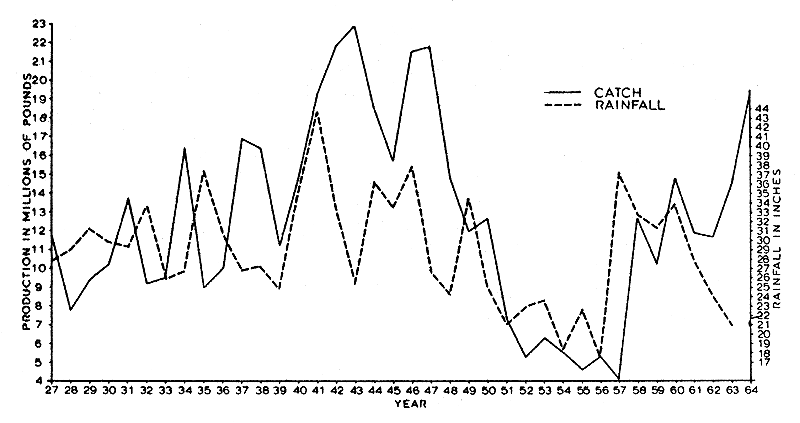
Fig. 1 Relationship between the annual catch of white shrimp and the average annual rainfall, of the same year, for the State of Texas.

Fig. 2 Relationship between the annual catch of white shrimp and the average annual rainfall, of the same year and the previous year, for the State of Texas.
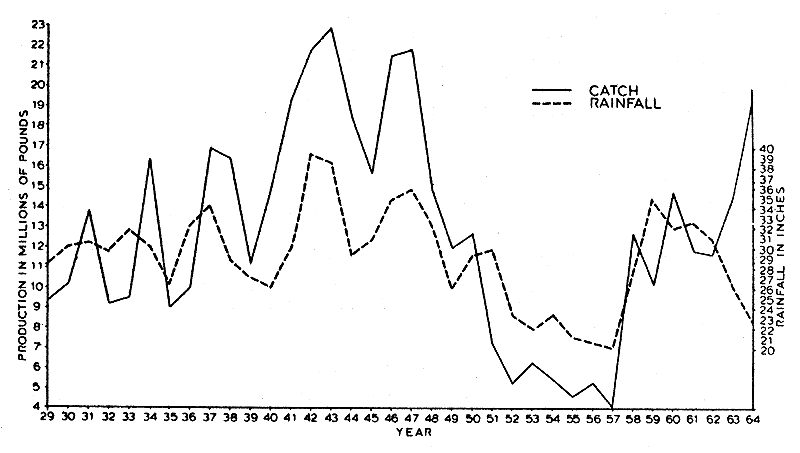
Fig. 3 Relationship between the annual catch of white shrimp and the average annual rainfall, of the two previous years, for the State of Texas.
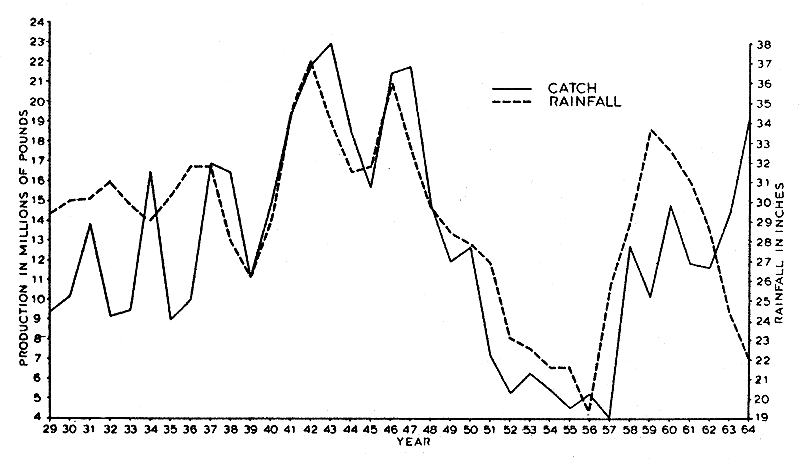
Fig. 4 Relationship between the annual catch of white shrimp and the average annual rainfall, of the same year and two previous years, for the State of Texas.
It can be seen from Table I that the correlation between the year's catch and the rainfall of the same year was significant only at the 10 percent level. The correlation between the catch of the year and rainfall of the same and the previous year were significant at the 1 percent level. The highest correlation, significant at 0.1 percent, was seen when the year's catch was correlated with the rainfall of the two previous years. A close correlation, also significant at the 0.1 percent level, was found between the average rainfall for the year and two previous years as related to the year's catch.
From these results, it becomes clear that over a period of 38 years, from 1927 to 1964, the catch of the white shrimp, Penaeus fluviatilis, on the Texas coast is positively correlated with the rainfall. The conclusions of the earlier authors (Hildebrand and Gunter, 1953; Gunter and Hildebrand, 1954) are strongly confirmed.
3.2 White shrimp production and outflow of the Mississippi River System into Louisiana waters
The Mississippi River drains water from one-third of the continental United States. There are two main distributaries, the main river, and the Atchafalaya River. The water these two rivers discharge into Louisiana bays is of overwhelming importance as compared to the local rainfall in its effect on the salinity. Therefore, the mean daily discharge of the two rivers was used in an effort to determine whether the discharge rate bore a relation to the production of white shrimp in Louisiana waters. This discharge occurs at the rate of several millions of ft3/s.
Data on the annual catches of shrimp in Louisiana have been taken from the Fishery Statistics of the United States, except for the years 1933 and 1935, and the years 1941 to 1947, which were based on tax records of Louisiana. The publication, Annual Maximum, Minimum, and Mean Discharges of the Mississippi River and its Outlets and Tributaries to 1953, by the Mississippi River Commission, Vicksburg, was the source for the mean river discharge data through 1953. Data for 1954 to 1964 were supplied by the New Orleans District, U.S. Army Corps of Engineers.
The annual landings of white shrimp and the daily average flow of the Atchafalaya and Mississippi Rivers are presented in Fig. 5 to 8, and the results of the statistical analysis of these figures for correlations are given in Table II. The data show no significant correlation between the shrimp catches and the flow of these rivers. When the r values for the four sets of criteria are examined (Table II), it becomes evident that there is no correlation even at the 10 percent level. The two factors follow independent patterns of fluctuations from 1927 through 1964.
This situation is in contrast to the conditions on the Texas coast, where increased rainfall and the consequent dilution of the coastal waters results in augmented catches of white shrimp. Similar to the findings of Ezekiel (1942) in relation to cotton production, high salinity (low fresh water inflow) is not a limiting factor to shrimp production in Louisiana. On the Louisiana coast, the increase or decrease of river discharge does not appear to affect the catches.
One more point deserves some consideration. The Louisiana shrimpers have always been leaders in the Gulf and their boats have ranged far and wide. However, when they go to Campeche and Florida, they catch pink shrimp, and when they go to Texas, they catch mostly brown shrimp. The figures given above are mostly landings, but the large majority of the white shrimp were taken in Louisiana. It is unlikely that white shrimp catches from outside of the state would be high enough to have a significant effect on the figures of white shrimp production for Louisiana.
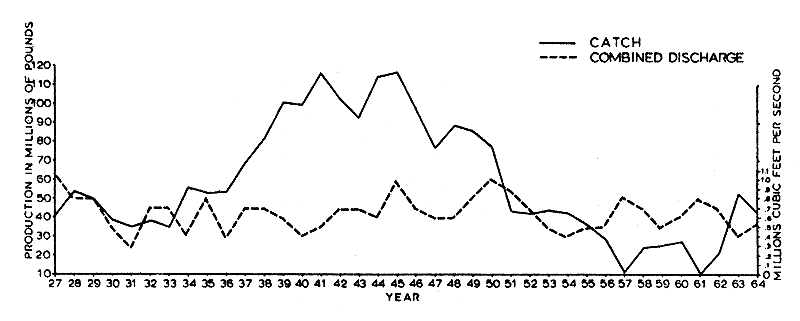
Fig. 5 Relationship between the annual catch of white shrimp and the combined daily average discharge of the Atchafalaya and Mississippi Rivers into Louisiana waters, for the same year.
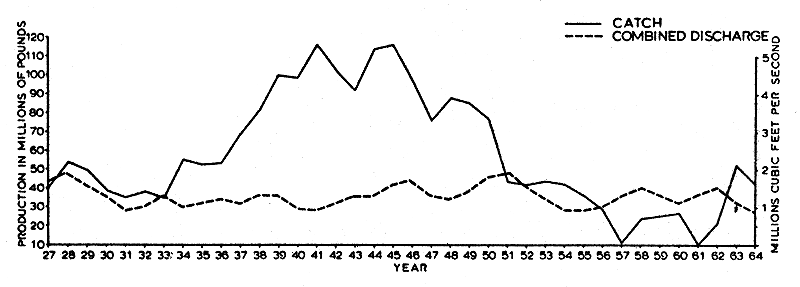
Fig. 6 Relationship between the annual catch of white shrimp and the combined daily average discharge of the Atchafalaya and Mississippi Rivers into Louisiana waters, for the same year and previous year.
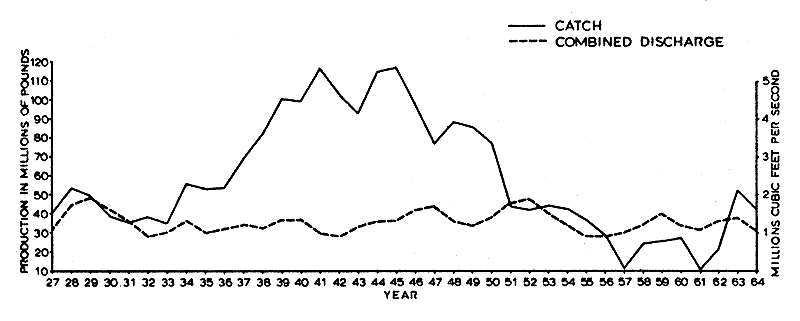
Fig. 7 Relationship between the annual catch of white shrimp and the combined daily average discharge of the Atchafalaya and Mississippi Rivers into Louisiana waters, for the two previous years.
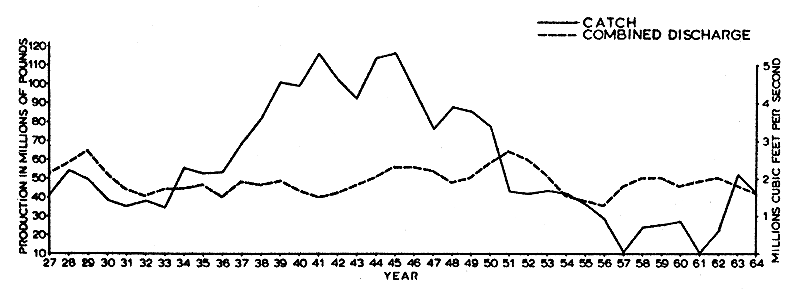
Fig. 8 Relationship between the annual catch of white shrimp and the combined daily average discharge of the Atchafalaya and Mississippi Rivers into Louisiana waters, for the same year and two previous years.
Probably the minimum flow of the rivers every year is sufficient for the white shrimp populations on the Louisiana coast, and presumably the fluctuations in the catches are due to other factors.
TABLE II
Correlations and significance levels between annual white shrimp catch and the combined daily average discharge of the Atchafalaya and Mississippi Rivers into Louisiana waters, 1927–1964
| Years compared | Degrees of freedom | r | Significance |
| 10% level | |||
| Catch with combined discharge, same year | 36 | .067 | .271 |
| Catch with combined discharge, of year and year before | 36 | .044 | .271 |
| Catch with combined discharge of two previous years | 36 | .029 | .271 |
| Catch with combined discharge of year and two years before | 36 | .074 | .271 |
3.3 Brown shrimp catch and rainfall in Texas waters
As stated in the introduction, the white shrimp population was not of sufficient strength to support the demand for shrimp after a vigorous program of selling and advertising had carried the Gulf shrimp into markets throughout the U.S.A. The brown shrimp were introduced into the market by Texas cooperative associations in 1948, and since then annual production of brown shrimp has consistently surpassed that of white shrimp. Although we do not have a long series of years with which to work, it was thought worthwhile to examine the relationship between the production of brown shrimp and the rainfall of the state.
Gunter (1962) has shown that brown shrimp account for approximately 60 percent of the Texas shrimp landings and Gunter, Christmas and Killebrew, (1964) reported that brown shrimp are most abundant off the Texas coast.
The bait shrimp catch from 1959 to 1964 was estimated from information given the Bureau of Commercial Fisheries Laboratory at Galveston and the Texas Parks and Wildlife Commission. These figures were added to the commercial landings of brown shrimp.
TABLE III
Correlations and significance levels between annual brown shrimp catch and annual rainfall for the State of Texas, 1948–1964
| Years compared | Degrees of freedom | r | Significance | Significance |
| 10% level | 5% level | |||
| Catch and rainfall, same year | 15 | -.002 | .412 | .482 |
| Catch with rainfall of year and year before | 15 | -.122 | .412 | .482 |
| Catch with rainfall of the two previous years | 15 | -.351 | .412 | .482 |
| Catch with rainfall of year and two years before | 15 | -.269 | .412 | .482 |
Comparisons between the annual catch and average rainfall are shown in Fig. 9 to 12. The pattern of fluctuations of the two factors between 1948 and 1964 shows no correlation. Statistical treatment of the catches of the year and (i) the same year's rainfall, (ii) rainfall of the year and the previous year, (iii) rainfall of the two previous years, and (iv) rainfall of the year and the two previous years, shows this point beyond doubt. The r values range from -.002 to -.351 (Table III), indicating no significant correlation. However, a longer series of data may show a significant negative correlation between catch and rainfall, which would be expected of a shrimp adapted to a dry, high salinity coast.
3.4 Brown shrimp production and outflow of the Mississippi River System into Louisiana waters
The Louisiana brown shrimp production or catch data are available for only a few years. The available data on browns are presented in Fig. 13 to 16. It can be seen from Table IV that the shrimp catches have no correlation to the river discharge over the years 1956 to 1964, the r value being -.485. The fluctuations follow a random pattern for both factors.
When the average daily river discharge (i) for the same year, (ii) for the year and the previous year, (iii) for the two previous years and (iv) for the year and the two previous years are examined in relation to brown shrimp landings, it is obvious that no correlation exists between them. The four values range from 0.033 to -.485.
Brown shrimp populations are apparently not affected significantly by the river flow. On the other hand, indications are that a negative correlation might become apparent with a longer series of data.
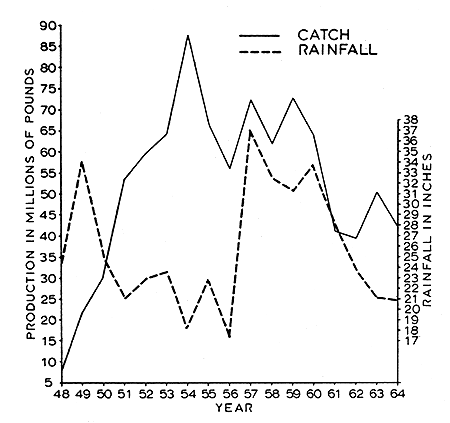 | 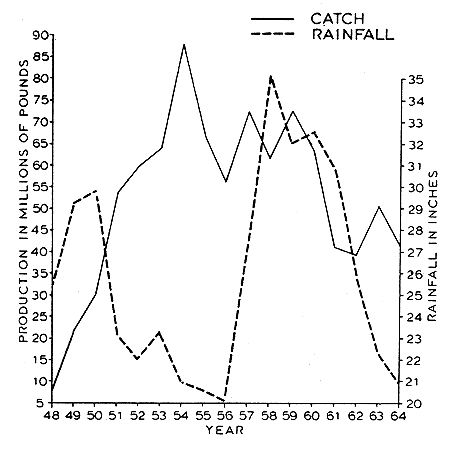 |
Fig. 9 Relationship between the annual catch of brown shrimp and the average annual rainfall, of the same year, for the State of Texas. | Fig. 10 Relationship between the annual catch of brown shrimp and the average annual rainfall, of the same year and the previous year, for the State of Texas. |
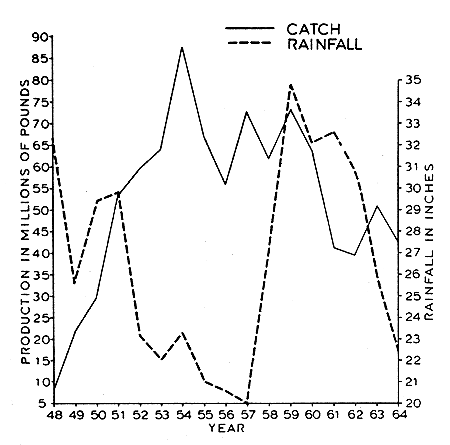 |  |
Fig. 11 Relationship between the annual catch of brown shrimp and the average annual rainfall, of the two previous years, for the State of Texas. | Fig. 12. Relationship between the annual catch of brown shrimp and the average annual rainfall, of the same year and two previous years, for the State of Texas. |
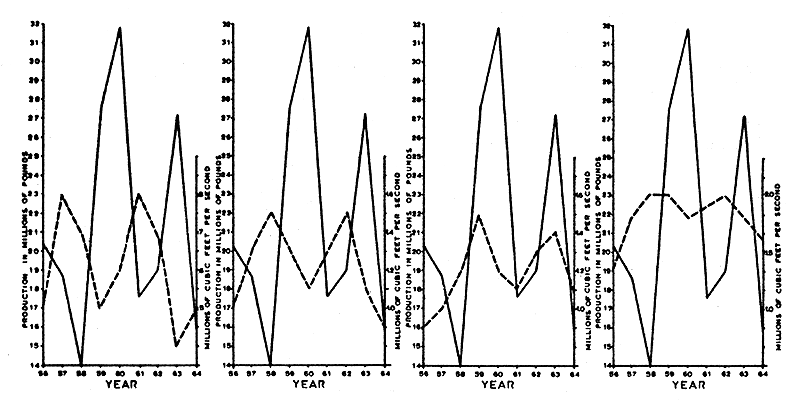 | |||
| Fig. 13 | Fig. 14 | Fig. 15 | Fig. 16 |
Fig. 13 Relationship between the annual catch of brown shrimp and the combined daily average discharge of the Atchafalaya and Mississippi Rivers into Louisiana waters, for the same year.
Fig. 14 Relationship between the annual catch of brown shrimp and the combined daily average discharge of the Atchafalaya and Mississippi Rivers into Louisiana waters, for the same year and previous year.
Fig. 15 Relationship between the annual catch of brown shrimp and the combined daily average discharge of the Atchafalaya and Mississippi Rivers into Louisiana waters, for the two previous years.
Fig. 16 Relationship between the annual catch of brown shrimp and the combined daily average discharge of the Atchafalaya and Mississippi Rivers into Louisiana waters, for the same year and two previous years.
TABLE IV
Correlations and significance levels between annual brown shrimp catch and the combined daily average discharge of the Atchafalaya and Mississippi Rivers into Louisiana waters, 1956–1964
| Years compared | Degrees of freedom | r | Significance | Significance |
| 10% level | 5% level | |||
| Catch with combined discharge same year | 7 | -.485 | .582 | .666 |
| Catch with combined discharge of year and year before | 7 | -.279 | .582 | .666 |
| Catch with combined discharge of two previous years | 7 | .484 | .582 | .666 |
| Catch with combined discharge of year and two years before | 7 | .033 | .582 | .666 |
Penaeid shrimps have efficient osmoregulation processes (Robertson, 1960). Different species show different salinity preferences, but the role salinity plays in governing the populations is not fully understood. Moreover, river discharge and land drainage may also affect temperatures of coastal waters, and whether this correlates with the production trends has not been investigated.
White and brown shrimp spawn offshore in high salinity waters of the open Gulf and the postlarvae inhabit the low salinity waters. The browns grow to a size of 90 to 100 mm in three months, and the whites grow up to 150 mm in six months. These young adults support the coastal fishery. Fluctuations in annual catches may be due to factors such as rainfall, recruitment, mortality in the natural populations, or movements of shrimp away from the general fishing grounds. The exact relationship between the ecological factors and the movements of the shrimp populations is not yet understood.
The data show that white shrimp production has a positive correlation with rainfall in Texas and also that there is a significant lag effect. That is to say, the catch is correlated with rainfall of the previous two years on the Texas coast. Brown shrimp production shows no such relationship. On the contrary, neither the white shrimp nor the brown shrimp catches off Louisiana fluctuate in relation to the river discharge. Though the principle involved is the same, i.e. dilution of coastal waters due to land drainage after rains or increased river flow, it is interesting that white shrimp production should exhibit a different correlation in Texas to that on the Louisiana coast. Gunter, Christmas and Killebrew, (1964) have shown that small white shrimp prefer salinities below 10‰. Therefore, increased rainfall and dilution of coastal waters might prove more favorable to white shrimp in Texas, as has been pointed out by Gunter and Hildebrand (1954). The lag effect in production may be due in part to a lag in the rise and fall of salinity of coastal and offshore waters following wet and dry spells.
Johnson and Fielding (1956) have shown experimentally that low salinity, per se, is not necessary for the survival and growth of the white shrimp under artificial conditions. However, the fact that increased rainfall is followed by a greater catch of white shrimp off the Texas coast has been shown in this study and those of earlier investigators. The fact that Louisiana white shrimp production shows no correlation with river discharge may appear to be contradictory. However, there is a high minimum discharge of the rivers along the Louisiana coast, and the white shrimp is the dominant species. There may be a population well adapted to this environment, and more river discharge may not affect the situation except to induce the whites to move farther down the bays. While less saline waters off the Texas coast may favor a white shrimp migration inshore, because the waters are definitely more salty, increased river discharge may have exactly the opposite effect off Louisiana. In any case this correlation is apparently related with salinity per se or some factor governed by salinity.
Gunter, Christmas and Killebrew (1964) have shown that the small brown shrimp are abundant in salinities between 10 to 20‰. They also state that “small shrimp have optimum salinities, which are different for different species, and which they select after entering the bays, although this selection may be entirely passive”. It appears, therefore, that the increased rainfall off Texas and more river discharge off Louisiana might cause the abundance of brown shrimp to decline, by reducing the salinities of the inshore waters to below the optimum for the species. Possibly, this explains the suggested negative correlation of brown shrimp production and river flow in Louisiana.
From the present study, it appears that the white shrimp catch off the Texas coast is positively correlated with the rainfall of the state, but the browns exhibit no such correlation.
Anderson, W.W., M.J. Lindner and J.E. King, 1949 The shrimp fishery of the southern United States. Comml Fish.Rev. 11(2):1–17 also issued as Fishery Leafl.U.S. Fish Wildl.Serv., (368):17 p.
Bullis, H.R., Jr., 1955 Shrimp exploration and gear research in the Gulf of Mexico. Proc. Indo-Pacif.Fish.Coun., 6(2–3):431–3
Ezekiel, W.N., 1942 Cotton root rot, the weather and cotton yields. Trans.Tex.Acad.Sci., 24:63–8
Gunter, G., 1950 Seasonal population changes and distributions as related to salinity, of certain invertebrates of the Texas coast, including the commercial shrimp. Publs Inst.mar.Sci.Univ.Tex., 1(2):7–51
Gunter, G., 1962 Shrimp landings and production of the State of Texas for the period 1956–1959, with a comparison with other Gulf States. Publs Inst.mar.Sci.Univ. Tex., 8:216–26
Gunter, G., 1963 The fertile fisheries crescent. J.Miss.Acad.Sci., 9:286–90
Gunter, G. and H.H. Hildebrand, 1954 The relation of total rainfall of the State and catch on the marine shrimp (Penaeus setiferus) in Texas waters. Bull.mar.Sci. Gulf Caribb., 4(2):95–103
Gunter, G., J.Y. Christmas and R.K. Killebrew, 1964 Some relations of salinity to population distributions of motile estuarine organisms, with special reference to penaeid shrimp. Ecology, 45(1):181–5
Hildebrand, H.H., and G. Gunter, 1953 Correlation of rainfall with Texas catch of white shrimp, Penaeus setiferus (Linnaeus), Trans.Am.Fish.Soc., 82:151–5
Johnson, N.C. and J.R. Fielding, 1956 Propagation of the white shrimp Penaeus setiferus (Linnaeus) in captivity. Tulane Stud.Zool., 4(6):175–90
Lindner, N.J. and W.W. Anderson, 1956 Growth, migrations and spawning, and size distributions of shrimp Penaeus setiferus. Fishery Bull.Fish Wildl.Serv.U.S., 56(106):555–645
Pearson, J.C., 1939 The early life histories of some American Penaeidae, chiefly the commercial shrimp, Penaeus setiferus (Linnaeus). Bull.Bur.Fish.Wash., 49(30):73 p.
Robertson, J.D., 1960 Osmotic and ionic regulation. In The physiology of Crustacea, edited by T.H. Waterman, New York, Academic Press, vol.1, pp. 317–39
Springer, S., 1951 Expansion of Gulf of Mexico shrimp fishery. 1945–50. Comml Fish.Rev., 13(9):1–6
USFWS, 1948 Fishery Biology Branch, The shrimp and the shrimp industry of the South Atlantic and Gulf of Mexico, Fishery Leafl.Fish Wildl.Serv.U.S., (319):1–5
Williams, A.B., 1955 A contribution to the life histories of commercial shrimps (Penaeidae) in North Carolina. Bull.mar.Sci.Gulf Caribb., 5(2):116–46
Anonymous, 1966 Gulf and South Atlantic landings, 1965. Comml Fish.Rev. 28(9): 31 p.